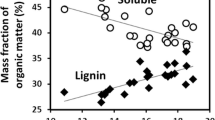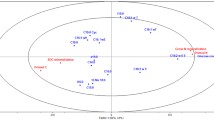Abstract
Ecosystems with high rates of nitrogen fixation often have high loss rates through leaching or possibly denitrification. However, there is no formal theoretical context to examine why this should be the case nor of how nitrogen accumulates in such open systems. Here, we propose a simple model coupling nitrogen inputs and losses to carbon inputs and losses. The nitrogen balance of this model system depends on plant (nitrogen fixer) growth rate, its carrying capacity, N fixed/C fixed, residence time of nitrogen and carbon in biomass, litter decay rate, litter N/C, and fractional loss rate of mineralized nitrogen. The model predicts the requirements for equilibrium in a nitrogen-fixing system, and the conditions on nitrogen fixation and losses in order for the system to accumulate nitrogen and carbon. In particular, the accumulation of nitrogen and carbon in a nitrogen-fixing system depend on an interaction between residence time in vegetation and litter decay rate in soil. To reflect a possible increased uptake of soil nitrogen and decreased respiratory cost of symbiotic nitrogen fixers, the model was then modified so that fixation rate decreased and growth rate increased as nitrogen capital accumulated. These modifications had only small effects on carbon and nitrogen accumulation. This suggests that switching from uptake of atmospheric nitrogen to mineral soil nitrogen as nitrogen capital accumulates simply results in a trade-off between energetic limitations and soil nitrogen limitations to carbon and nitrogen accumulation. Experimental tests of the model are suggested.
Similar content being viewed by others
References
Bigger M & Cole D (1983) Effects of harvesting intensity on nutrient losses and future productivity in high and low productivity red alder and Douglas-fir stands. In: Ballard R & Gessel S (Eds) IUFRO Symposium on Forest Site and Continuous Productivity (pp 167–178). USDA Forest Service General Technical Report PNW-133, Portland
Binkley D (1992) Ecology of mixtures of nitrogen-fixing trees and other species. In: Cannell M (Ed) Ecology of mixed-species stands (pp 92–123). Cambridge University Press, Cambridge, England
Binkley D, Sollins P, Bell R, Sachs R & Myrold D (1992) Biogeochemistry of adjacent conifer and alder-conifer stands. Ecology 73: 2022–2033.
Binkley D & Giardina C (1997) Nitrogen fixation in tropical forest plantations. In: Nambiar EKS & Brown A (Eds) Management of Soil, Water and Nutrients in Tropical Plantation Forests (pp 297–337). CIFOR/CSIRO/ACIAR, Canberra, Australia
Boring LR, Swank WT, Waide JB & Henderson GS (1988) Sources, fates, and impacts of nitrogen inputs to terrestrial ecosystems: Review and synthesis. Biogeochemistry 6: 119–159
Caldwell MM & Virginia RA (1991) Root systems. In: Pearcy RW, Elheringer J, Mooney HA & Rundell PA (Eds) Plant Physiological Ecology: Field Methods and Instrumentation (pp 367–398). Chapman and Hall, New York
Carlson PJ & Dawson JO (1985) Soil nitrogen changes, early growth, and response to internal drainage of a plantation of Alnus jorullensis in the Columbian Highlands. Turrialba 35: 141–150
Compton JE (1994) Phosphorus dynamics in red alder and Douglas-fir stands. Ph.D. Dissertation, University of Washington, Seattle, Washington
Davidson EA, Myrold DD & Groffman PM (1990) Denitrification in temperate forest ecosystems. In: Gessel SP, Lacate DS, Weetman GF & Powers RF (Eds) Sustained Productivity of Forest Soils (pp 196–220). University of British Columbia, Faculty of Forestry Publications, Vancouver, British Columbia, Canada
Giardina CP, Huffman S, Binkley D & Caldwell BA (1995) Alders increase soil phosphorus availability in a Douglas-fir plantation. Canadian Journal of Forest Research 25: 1652–1657
Gotelli, NJ (1995) A primer of ecology. Sinauer Associates, Incorporated, Sunderland, Massachusetts.
Hibbs D, DeBell D & Tarrant R (Eds) (1994) The biology and management of red alder. Oregon State University Press, Corvallis, Oregon
Marschner H (1995) Mineral Nutrition of Higher Plants. Academic Press, New York
MacDicken KG (1994) Selection and management of nitrogen-fixing trees. Winrock International Institute for Agricultural Development, Morrilton, Arkansas
National Research Council (1979) Tropical Legumes: Resources for the Future. National Academy of Sciences, Washington, DC
Olson JS (1963) Energy Storage and the Balance of Producers and Decomposers in Ecological Systems. Ecology 44: 321–331
Parrotta JA, Baker DD & Fried M (1994) Application of 15N-enrichment methodologies to estimate nitrogen fixation in Casuarina equisetifolia. Canadian Journal of Forest Research 24: 201–207
Parrotta JA, Baker DD & Fried M (1996) Changes in dinitrogen fixation in maturing stands of Casuarina equisetifolia and Leucaena leucocephala. Forest Science 26: 1684–1691
Reporter M (1985) Nitrogen fixation. In: Coombs J, Hall DO, Long SP & Scurlock JMO (Eds) Techniques in bioproductivity and photosynthesis (pp 158–164). Pergamon Press, Oxford, England
Silvester WB (1983) Analysis of nitrogen fixation. In: Gordon JC & Wheeler CT (Eds) Biological Nitrogen Fixation in Forest Ecosystems: Foundations and Applications (pp 173–212). Martinus Nijhoff, The Hague, The Netherlands
Sprent J & Sprent P (1990) Nitrogen Fixing Organisms. Chapman and Hall, London, England
Struwe S & Kjoller A (1991) Denitrification in forest ecosystems. Forest Ecology and Management (special issue) 44: 1–92
Van Miegroet H, Cole D & Homann P (1990) The effect of alder forest cover and alder forest conversion on site fertility and productivity. In: Gessel S, Lacate D, Weetman G & Powers P (Eds) Sustained Productivity of Forest Soils (pp 333–354). University of British Columbia Press, Vancouver
von Bertalanffy, L (1968) General System Theory. George Braziller, New York
Wolfram S (1991) Mathematica: A System for Doing Mathematics by Computer. Addison-Wesley Publishing Company, Inc., New York
Author information
Authors and Affiliations
Rights and permissions
About this article
Cite this article
Pastor, J., Binkley, D. Nitrogen fixation and the mass balances of carbon and nitrogen in ecosystems. Biogeochemistry 43, 63–78 (1998). https://doi.org/10.1023/A:1006057428096
Issue Date:
DOI: https://doi.org/10.1023/A:1006057428096




